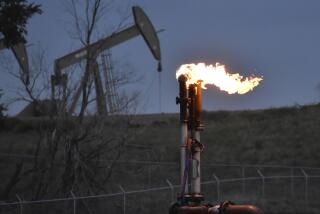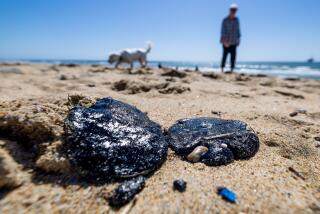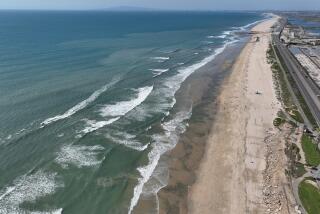Leaking gas may give clue to size of gulf oil spill
- Share via
A Santa Barbara scientist has proposed computing the size of the oil spill in the Gulf of Mexico by measuring its cousin, natural gas, which is spewing into the gulf along with it.
In an article published in the British journal Nature this week, UC Santa Barbara geochemist David Valentine said that dragging gas sensors through the waters near the spill could provide data on how much methane was lurking in the ocean. From that figure, the volume of oil could be derived, he said.
The leaking oil has high concentrations of methane, perhaps as much as 40% by mass, he said. But unlike oil, methane dissolves in water and can be measured empirically, Valentine said. Once the level of methane is determined, the amount of oil can be calculated, he said.
“What it gives you is a very good lower limit” on how much oil is flowing, said Valentine, whose research focuses in part on how methane behaves in the ocean.
BP effectively admitted last week that its estimates of the oil spill were too low when the company announced that a siphon on the broken pipe was extracting 5,000 barrels of oil a day — and this was only a portion of the total oil gushing out of the pipe.
Earlier, officials had estimated the size of the entire gush at 5,000 barrels a day, but some scientists had said the amount may be much higher.
In his report, Valentine argues that merely observing the size of the surface slick or trying to estimate its size from video images of the busted pipe is unreliable. There is too much variation, he said.
By contrast, a measurement of methane trapped 300 feet or more underwater could yield a more accurate projection of the size of the leak, he said.
Scientists using real-time instruments to take samples could assess how much the oil spill has increased natural background levels of methane in the water. Once they have gathered sufficient data, they could essentially map methane plumes under the waves and track their movements.
Although small amounts of methane may be eaten by microbes or escape into the air, Valentine said the degree of this loss could be estimated.
The U.S. academic research fleet has vessels and equipment that could do the work, and the cost would probably be “a few million dollars or less,” Valentine wrote. But he said the work needed to begin quickly before plumes disperse.
Valentine said that so far, he had floated his idea among officials involved with the spill and had received a favorable response. But he acknowledged that “nobody said they were going to do it yet.”
More to Read
Sign up for Essential California
The most important California stories and recommendations in your inbox every morning.
You may occasionally receive promotional content from the Los Angeles Times.










